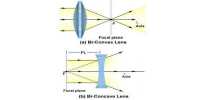When we see an object, then the light from the object falls on our eyes. The light being refracted by the lens of eye forms an image of the object on retina. There are numerous nerves in retina which send this perception to brain. We can see the object after the perfect analysis of the signals in the brain.
The nerves that have reached the brain from retinas are called rods and cones. Among them the cones cells are colour sensitive. There are three types of cone cells — blue colour sensitive, red colour sensitive and green colour sensitive cone cells. It does not matter whether the colour is compound or complex, the eye perceives the colour of an object in terms of these three colours.
The cone cells of retina send the accumulated information to brain. Brain separates all these colours through a particular process. Thus we can perceive the colour of coloured object.
We know that when the object is at infinity its virtual image is formed at the principal focus of the concave lens. Therefore, the focal length of the concave lens used as spectacles should be equal to the distance of the far point of the defective eye.











